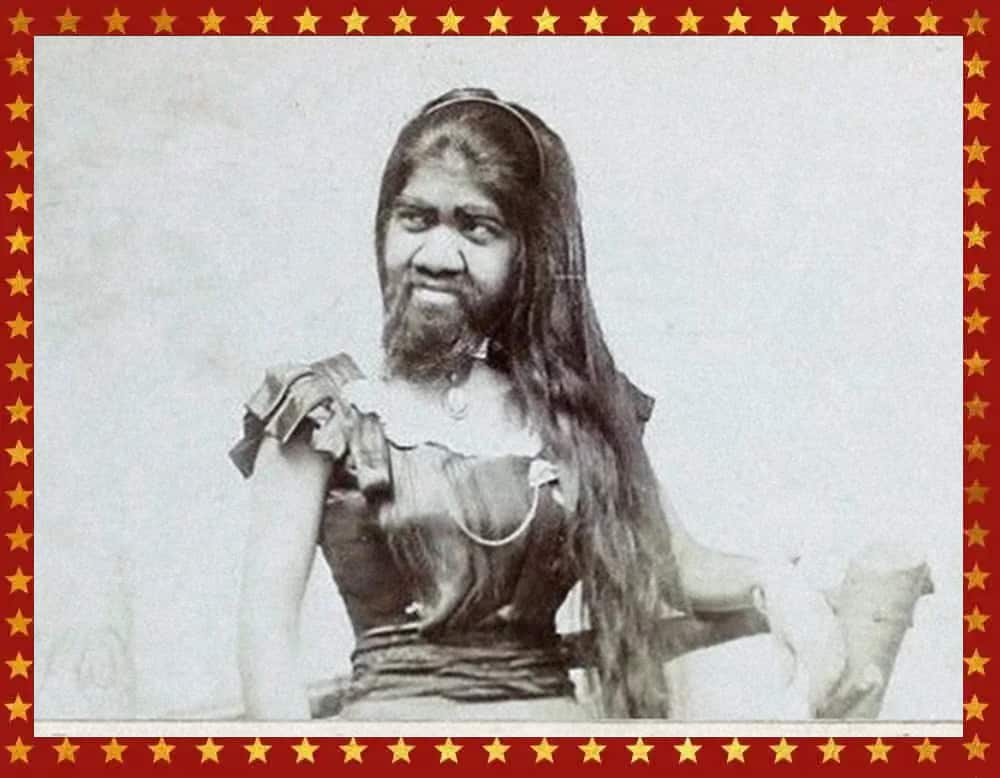
The Missing Link

Content Warning: The circus side show industry predominantly employed individuals with disabilities who faced challenges in securing alternative employment opportunities. Despite these obstacles, many of them enjoyed substantial financial compensation and lived fulfilling lives. The primary objective of this article is to provide knowledge and commemorate the lives of these individuals. It should be emphasized that the intention is not to diminish their worth or dignity based on their disabilities.
The following content contains sensitive material that may be distressing or triggering for some individuals. Reader discretion is advised.
Krao Farini, born in 1876 and passing away on April 16, 1926, was an American sideshow performer renowned for her hypertrichosis, a condition that resulted in excessive hair growth. During the 19th century, she embarked on exhibition tours across North America and Europe, captivating audiences with her unique appearance. Unfortunately, her life was marked by exploitation and false advertising, as she was adopted by William Leonard Hunt, also known as Guillermo Antonio Farini, who sought to profit from her unusual features. She was deceitfully presented as a primitive human, falsely billed as the missing link connecting humans and apes.
According to certain accounts, Krao Farini was believed to have been born in Laos, which was then a province in northern Siam. However, given the nature of sideshow performers’ biographies, it is challenging to discern the extent of truth in her recorded life.
It is claimed that in January 1881, Krao and her parents were allegedly captured during an expedition led by explorer Carl Bock in what is now northern Thailand and Laos. Dr. George Shelly, an anthropologist who was part of the expedition, assumed responsibility for Krao’s well-being. She was described as a member of a primitive tribe called the “Kraos-monink,” believed to dwell in trees and characterized by their hair-covered bodies.
Bock and Shelley faced a challenging task in capturing the Kraos-monink, as the Siamese people required persuasion through bribes due to their belief that harming or capturing them would bring bad luck. Krao’s mother was detained in Bangkok, while her father tragically succumbed to cholera. According to accounts, the Kraos-monink tribe was purportedly unfamiliar with fire and sustained themselves on fruits, fish, and nuts. Krao’s Siamese name was said to translate to “ape,” reflecting the prevailing perception of her appearance. In addition to her excessive body hair, Krao was described as having various anatomical anomalies, including an extra thoracic vertebra, an additional pair of ribs, cheek pouches, hypermobility of joints, and a lack of cartilage in her ears and nose.
Dr. George G. Shelly offered another perspective on Krao’s origins. He recounted that in approximately 1874, Carl Bock traveled to Burma on behalf of Guillermo Antonio Farini in search of exceptionally tall individuals. During his visit to the court of the Burmese king, Bock encountered the grandchildren of a hairy couple who had previously been encountered by European explorers in the previous generation. These grandchildren were presented as gifts to the Burmese court by the King of Laos. Bock attempted to negotiate their acquisition with an offer of $100,000 to the Burmese king but was unsuccessful.
In 1882, Shelly and Bock embarked on several expeditions in pursuit of “hairy people.” They met in Singapore and journeyed to the Rembau District in Malaysia in search of a race known as the “Jaccoons,” believed to be ape-like beings. Failing to find evidence of the Jaccoons in Malaysia, they continued their quest to Rangoon and subsequently Bangkok. In Bangkok, they received assistance in the form of an escort, twenty elephants, and letters of introduction to the King of Laos. After four months, they arrived at the Laotian capital, which Shelly referred to as “Kjang-Kjang.” The King of Laos provided them with a military escort to remote swamps deep within the country, where they successfully captured and took Krao and her parents with them. Returning to the King of Laos, they encountered resistance when the king refused to allow Krao’s mother to leave the country. Tragically, the expedition was afflicted by a cholera outbreak in Chiang Mai, resulting in the death of Krao’s father, Schua Mayong.
According to a later account, Guillermo Antonio Farini became aware of the Krao people through a conversation with naturalist Francis Trevelyan Buckland, who mentioned their presence in the court of the Kings of Burma. Intrigued, Farini enlisted the assistance of the son of Queen Victoria’s jeweler to capture and transport some Krao individuals from the Burmese king. However, the king refused, fearing that his reign would come to an end if the Krao people left the country. Krao, along with her parents, Schua Mayong and her mother, were being held at the Burmese court, having been presented as a gift from the King of Laos.
Undeterred, Farini organized an expedition led by Carl Bock to locate the Krao people. Although Bock encountered a group of thirty to forty Kraos, he was unable to capture any of them. Returning to the Burmese king, Bock eventually gained permission to take Krao and her father. Tragically, the expedition was struck by a cholera outbreak in Chiang Mai, leading to the death of Krao’s father. After recovering, the expedition reached Bangkok six weeks later. The King of Siam initially opposed Bock’s plan to take Krao to Europe, but Prince Kronoiar intervened, having been helped by Bock in the past. As a result, Bock was allowed to proceed on the condition that Farini would adopt another individual named Kher.
In October 1882, Krao, Shelly, and Bock arrived in London. By 1883, Krao was exhibited throughout Europe as a supposed missing link between humans and apes, serving as a visual illustration of Charles Darwin’s theory of evolution. During her time in Europe, she acquired some knowledge of German and English. Guillermo Antonio Farini exhibited her at the Royal Aquarium in Westminster, and she adopted the surname “Farini” after being captured by the sideshow promoter. In early November 1884, Krao arrived in Philadelphia, still under the care of Dr. George Shelly, and was believed to be eight or nine years old at the time.
Krao spent several decades touring and exhibiting herself as a spectacle. In 1899, she embarked on a tour of the British Isles, making appearances in Cardiff and Edinburgh.
During the last years of her life, Krao resided in Brooklyn, specifically at 309 East Nineteenth Street. When in public but not on display, she concealed her appearance with a veil. She passed away from influenza on April 16, 1926, in Manhattan. In her final wishes, she requested to be cremated to avoid her body being subjected to further scrutiny.

Join Us
Subscribe to Twisted Carnival’s newsletter for an exhilarating journey into the realm of dark wonders, with captivating secrets, announcements, and exclusive offers, keeping you one step ahead and immersed in thrilling tales as part of their mesmerizing subscriber community.
Get a front-row seat to Twisted Carnival’s macabre spectacle on social media, with twisted artistry, mesmerizing performances, behind-the-scenes glimpses, and exclusive event updates, connecting you to a community of thrill-seekers and captivating tales.


